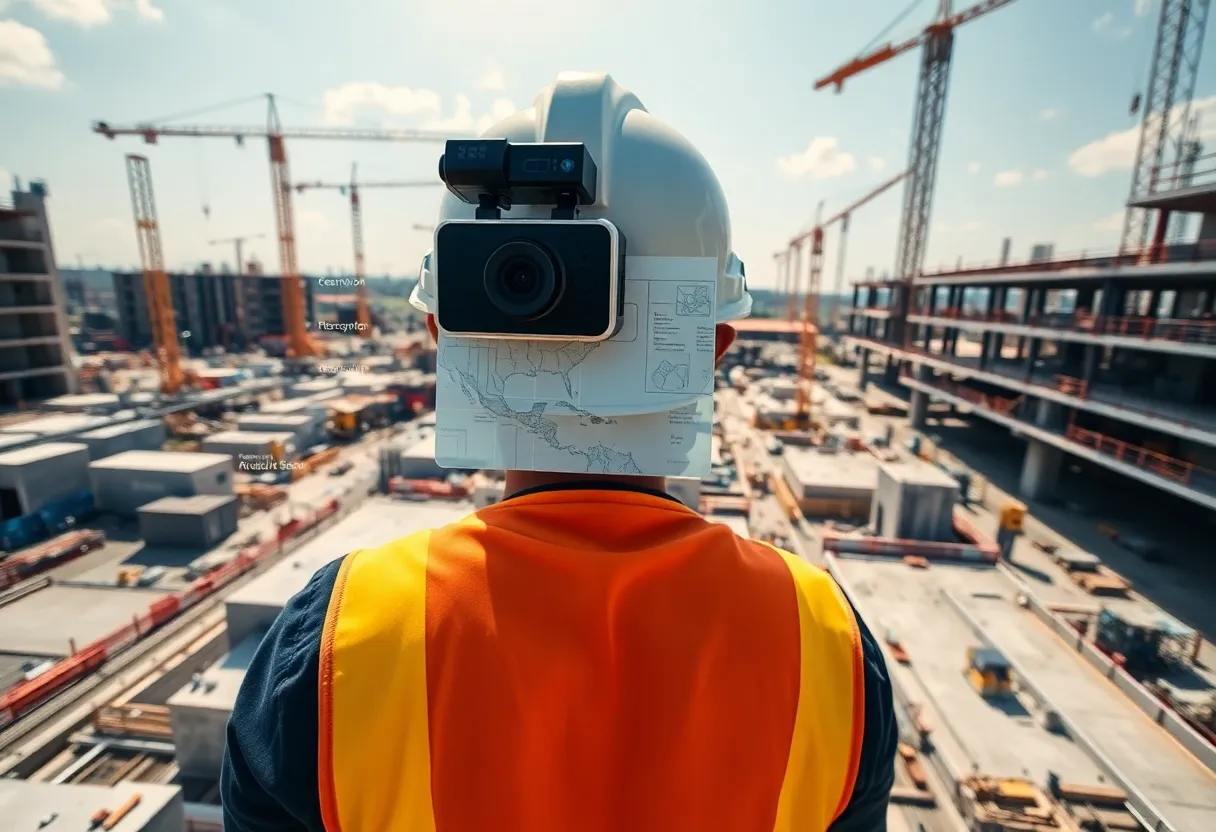Clay, New York, September 26, 2025
News Summary
Artificial intelligence cannot meaningfully reduce construction delays or budget overruns until jobsites collect structured, centralized data. The industry still relies on fragmented updates — messaging apps, paper checklists and scattered cloud folders — leaving analytics and AI models starved for reliable inputs. The piece compares construction to agriculture’s data-driven shift, highlights visual capture practices (helmet-mounted 360° cameras mapped to floor plans), and cites pilots: Zachry with ALICE for generative scheduling, Skanska’s Safety Sidekick, and Foresight’s consolidated forecasting. Practical steps: standardize workflows, digitize one process at a time, centralize records, and train teams so AI can deliver real value.
AI Won’t Fix Construction’s Cost and Schedule Gaps Until Jobsites Standardize Data — Micron Files 336‑Page Site Plan; NYC Jobs Lag; SPC Construction Forms
Key point: Artificial intelligence will not solve construction delays or budget overruns without structured, centralized data. The industry still relies on scattered tools — messaging apps, paper checklists and cloud folders — and those sources are often out of date. With fragmented and delayed information, AI remains a theoretical promise rather than a practical asset.
Big developments and why they matter
Major project news continues alongside industrywide digital questions. Micron Technology filed a detailed site plan with the town of Clay, New York for a planned chipmaking complex, a 336‑page submission that gives the clearest look yet at a sprawling campus and starts a town review needed before building. Meanwhile, a regional corporate reorganization created SPC Construction to focus on tunnels, bridges, roadways and water systems in the New York metro area. And a state‑level analysis shows New York City’s construction industry remains smaller than it was before the COVID‑19 pandemic, with implications for labor and permit processing.
Why structured data matters now
Two hard statistics underline the urgency: 20% of projects run late. 80% of projects go over budget. Industry observers link those outcomes directly to data gaps. When schedules, quantities, safety records and visual progress are captured inconsistently or updated infrequently, AI tools have nothing reliable to analyze. The result: automated models that feel disconnected from the realities of daily work.
How other sectors paved the way
Agriculture offers a direct analogy. A decade ago farming was seasonal, equipment‑heavy and driven by gut instinct. Farmers began sampling soil, logging yields, and flying drones. Once structured data points accumulated in agriculture, AI models informed growers when to irrigate or harvest. Structured inputs turned raw field data into precise, daily guidance for farmers. Construction can follow the same path by measuring and standardizing first, then applying AI.
Practical steps to prepare jobsites for AI
The prescription is straightforward: use a single platform that standardizes processes, empowers team collaboration, and captures and organizes data in one place. Implement structured digital processes as the essential first step toward making AI usable in everyday construction work. Work from the same plans, in the same place — choose the right software, align on standardized workflows, and ensure the whole team is trained and confident using it. Connect site and office teams using shared systems that sync in real time so everyone is working with the latest updates in a single project space. Centralize project data in the cloud to ensure seamless access, live collaboration and easy analysis regardless of team location.
How data must be captured
How data is captured matters as much as where it’s stored; data must be structured from the start for AI to use it. AI can only work with what it understands; site activity needs to be documented in consistent, clear and connected ways. Examples of structured capture include photos and videos pinned to digital floor plans, automatically tagged with timestamps and location for accurate context; predefined digital forms and templates that guide on‑site teams to consistently collect and report the right information; and centralized document management with workflows, approvals and records stored in one place for easy access and tracking. Not all data is created equal; photos and videos captured at the right moment, from the right place, with the right context are among the most valuable records.
Real deployments showing the path
Several builders and owners are already proving the model. One general contractor standardized takeoffs, crew rates and weather delays across projects before adopting a generative scheduling engine. Because inputs shared one format, the engine could ingest them and generate hundreds of buildable sequences in minutes. Early trials surfaced sequences that trimmed the critical path by up to two weeks and highlighted risks before ground was broken. A large builder standardized safety observations, toolbox talks and near‑miss reports into a central safety warehouse and launched a generative AI chatbot trained on its incident history; the result was more usable dashboards and a reported 40% reduction in time spent preparing toolbox talks. A global data‑center developer consolidated schedules from multiple Primavera and Project files into a single activity taxonomy, replaced annual uploads with weekly P6 APIs, and used probabilistic forecasting to avoid roughly $100 million in delay costs while cutting reporting costs dramatically.
Technology examples and future value
Forward‑thinking teams are integrating visual capture into daily routines to build consistent, project‑wide visual histories. One product example uses a helmet‑mounted camera to record site walks in 360° and automatically map imagery onto floor plans via an AI‑powered platform, creating a complete, structured visual log of how a site evolved over time. Benefits include comparing progress, validating installations without demolition, preventing rework, supporting faster issue resolution, and maintaining compliance with verifiable records. Structured visual datasets will fuel AI tools that detect deviations, spot patterns and forecast delays before they become costly, moving projects from reactive fixes to predictive, data‑driven delivery.
Project news details
Micron Technology filed a detailed site plan with the town of Clay, New York for a planned chipmaking complex. The filing is 336 pages and focuses heavily on the first fab: height of factory and ancillary buildings, landscaping, lighting and auxiliary systems. Each fab will cover 28 acres of land. Micron says it plans to spend up to $100 billion over the next 20 years building four fabs in succession, backed by up to $25 billion in taxpayer subsidies. The site plan submission launches a town review; the town planning board will review and vote on the site plan, and the town board will vote on rezoning the last three parcels acquired for the project last year. Micron will not need site‑plan approval to begin cutting trees and leveling the first 700 acres of the site this November. Construction on the first fab is scheduled to begin in late 2025.
In a workforce snapshot, New York City’s construction industry remains smaller than it was before the COVID‑19 pandemic. In 2024 the city averaged 143,100 construction jobs, an 11% decrease from 161,300 construction jobs in 2019. New York State remained 4% below its 2019 construction employment levels, making it the second‑slowest recovery of any state after West Virginia. The slow recovery has disproportionately harmed immigrants, who held 61% of the city’s construction jobs as of 2023. The report also found the number of construction‑related employees at the NYC Department of Buildings dropped from 662 in March 2021 to 519 in March 2024, and permit approval times increased.
Corporate structuring continued: FlatironDragados announced a spinoff of three longtime area companies to create SPC Construction, a regional civil construction firm that will operate as a subsidiary and target transportation and water infrastructure work in the New York metro region. The deal is targeted for completion by the end of the second quarter.
Bottom line
AI’s promise in construction depends on data: clean, consistent and complete. Start small, pick a frustrating workflow, digitize it, and standardize its inputs. Take one process. Digitize it. Structure it. That’s how to prepare for AI.
Reporting by Glenn Coin & Rick Moriarty
FAQ
Q: What is the main barrier to using AI in construction today?
A: Artificial intelligence will not solve construction delays or budget overruns without structured, centralized data.
Q: How common are delays and overruns?
A: 20% of projects run late. 80% of projects go over budget.
Q: What practical first steps should teams take to prepare for AI?
A: Implement structured digital processes as the essential first step toward making AI usable in everyday construction work. Work from the same plans, in the same place — choose the right software, align on standardized workflows, and ensure the whole team is trained and confident using it.
Q: What did Micron submit in New York?
A: Micron Technology filed a detailed site plan with the town of Clay, New York for a planned chipmaking complex. The site‑plan filing is 336 pages.
Q: What is the state of construction employment in New York City?
A: New York City’s construction industry remains smaller than it was before the COVID‑19 pandemic. In 2024 the city averaged 143,100 construction jobs, which is an 11% decrease from 161,300 construction jobs in 2019.
Q: What corporate change was announced for regional civil work?
A: FlatironDragados announced a spinoff of its New York and New Jersey subsidiaries to create SPC Construction.
{
“@context”: “https://schema.org”,
“@type”: “FAQPage”,
“mainEntity”: [
{
“@type”: “Question”,
“name”: “What is the main barrier to using AI in construction today?”,
“acceptedAnswer”: {
“@type”: “Answer”,
“text”: “Artificial intelligence will not solve construction delays or budget overruns without structured, centralized data.”
}
},
{
“@type”: “Question”,
“name”: “How common are delays and overruns?”,
“acceptedAnswer”: {
“@type”: “Answer”,
“text”: “20% of projects run late. 80% of projects go over budget.”
}
},
{
“@type”: “Question”,
“name”: “What practical first steps should teams take to prepare for AI?”,
“acceptedAnswer”: {
“@type”: “Answer”,
“text”: “Implement structured digital processes as the essential first step toward making AI usable in everyday construction work. Work from the same plans, in the same place — choose the right software, align on standardized workflows, and ensure the whole team is trained and confident using it.”
}
},
{
“@type”: “Question”,
“name”: “What did Micron submit in New York?”,
“acceptedAnswer”: {
“@type”: “Answer”,
“text”: “Micron Technology filed a detailed site plan with the town of Clay, New York for a planned chipmaking complex. The site‑plan filing is 336 pages.”
}
},
{
“@type”: “Question”,
“name”: “What is the state of construction employment in New York City?”,
“acceptedAnswer”: {
“@type”: “Answer”,
“text”: “New York City’s construction industry remains smaller than it was before the COVID‑19 pandemic. In 2024 the city averaged 143,100 construction jobs, which is an 11% decrease from 161,300 construction jobs in 2019.”
}
},
{
“@type”: “Question”,
“name”: “What corporate change was announced for regional civil work?”,
“acceptedAnswer”: {
“@type”: “Answer”,
“text”: “FlatironDragados announced a spinoff of its New York and New Jersey subsidiaries to create SPC Construction.”
}
}
]
}
Key features at a glance
| Feature | Why it matters | Example or data point |
|---|---|---|
| Structured, centralized data | Makes AI analysis accurate and actionable | Artificial intelligence will not solve construction delays or budget overruns without structured, centralized data |
| Project outcomes | Shows scale of current performance gaps | 20% of projects run late. 80% of projects go over budget. |
| Micron site plan | Major megaproject advancing through reviews | Micron Technology filed a detailed site plan with the town of Clay, New York for a planned chipmaking complex; the filing is 336 pages |
| Workforce snapshot | Labor recovery remains uneven | In 2024 the city averaged 143,100 construction jobs, an 11% decrease from 161,300 construction jobs in 2019 |
| Regional firm reorganization | Focused capability for tunnels, bridges and water systems | FlatironDragados announced a spinoff of its New York and New Jersey subsidiaries to create SPC Construction |
Deeper Dive: News & Info About This Topic
Additional Resources
- BoiseDev: Micron Clay expansion
- Wikipedia: Micron Technology
- The New York Times: OpenAI data centers in the United States
- Google Search: OpenAI data centers United States
- Crain’s New York: NYC construction jobs still below pre-pandemic levels
- Encyclopedia Britannica: New York City construction jobs
- Construction Dive: FlatironDragados forms SPC Construction
- Google Scholar: FlatironDragados SPC Construction
- CBS News: Construction continues on NYC’s first soccer stadium (video)
- Google News: NYC first soccer stadium construction
Author: Construction CA News
The CALIFORNIA STAFF WRITER represents the experienced team at constructioncanews.com, your go-to source for actionable local news and information in California and beyond. Specializing in "news you can use," we cover essential topics like product reviews for personal and business needs, local business directories, politics, real estate trends, neighborhood insights, and state news affecting the area—with deep expertise drawn from years of dedicated reporting and strong community input, including local press releases and business updates. We deliver top reporting on high-value events such as the Rose Parade, Coachella, Comic-Con, and the California State Fair. Our coverage extends to key organizations like the California Building Industry Association and Associated General Contractors of California, plus leading businesses in technology and entertainment that power the local economy such as Apple and Alphabet. As part of the broader network, including constructionnynews.com, constructiontxnews.com, and constructionflnews.com, we provide comprehensive, credible insights into the dynamic landscape across multiple states.




